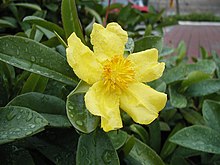Hibbertia scandens
| Snake vine | |
|---|---|
 |
|
| Scientific classification | |
| Kingdom: | Plantae |
| Clade: | Angiosperms |
| Clade: | Eudicots |
| Order: | Dilleniales |
| Family: | Dilleniaceae |
| Genus: | Hibbertia |
| Species: | H. scandens |
| Binomial name | |
|
Hibbertia scandens (Willd.) Dryand. |
|
Hibbertia scandens (also known as snake vine, climbing Guinea flower or golden Guinea vine) is a vine which is native to Australia.
The yellow flowers have been reported as having an unpleasant odour variously described as similar to mothballs or animal urine or sweet but with "a pronounced faecel element". The leaves are elliptic or obovate and average 6 cm in length.
The species was first formally described in 1799 by German botanist Carl Willdenow who gave it the name Dillenia scandens. The specific epithet scandens is derived from Latin, and means "to climb". In 1805, Swedish botanist Jonas Dryander transferred the species into the genus Hibbertia.
Hibbertia scandens occurs in an area that extends from south-eastern New South Wales upwards to north-east Queensland.
Hibbertia scandens appeared on an Australian postage stamp in 1999.
This species is commonly cultivated, and adapts to a wide range of growing conditions. Although it readily grows in semi-shaded areas, it flowers best in full sun.
...
Wikipedia
